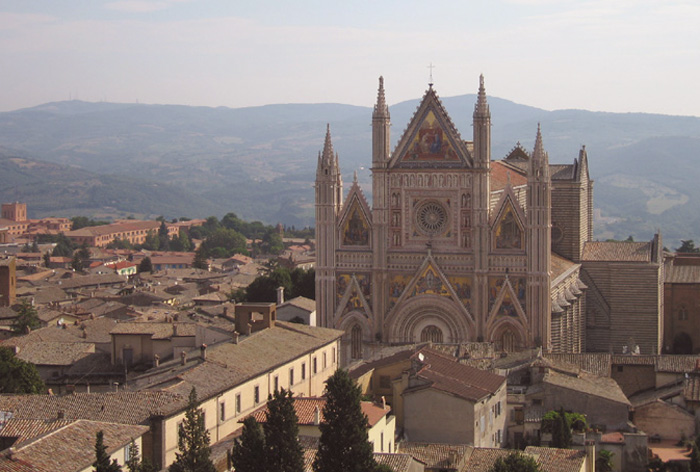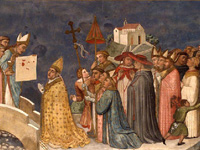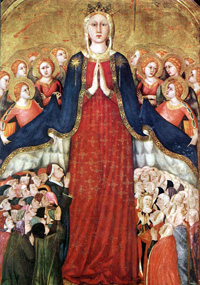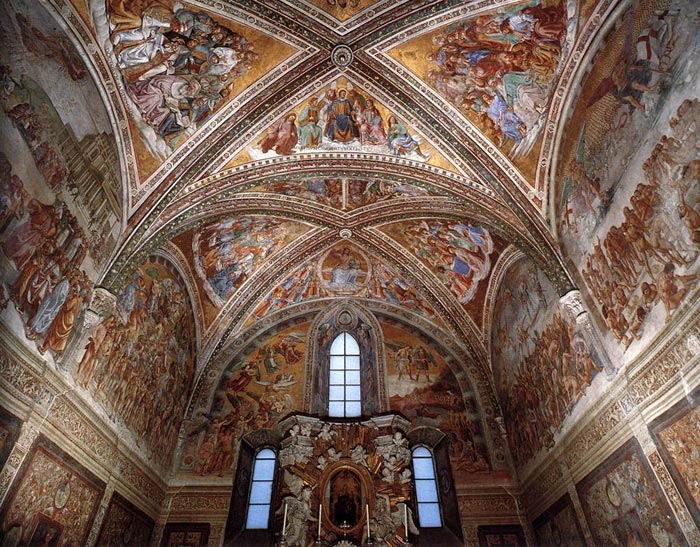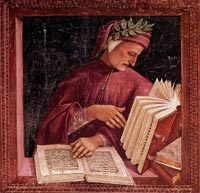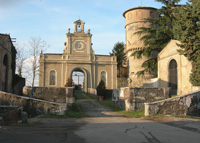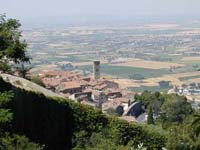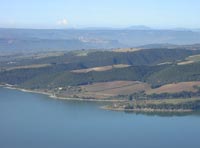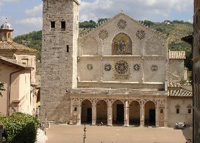The Chatedral of Orvieto |
The history of the Cathedral or Duomo of Orvieto began in 1290 when Pope Nicholas IV blessed the first stone. The new building was begun on the site of the church of S. Maria de episcopatu, the chapter church of San Costanzo and other possessions of the Chapter. The solemn inauguration of the work yard coincided with the period of maximum splendor of the city of Orvieto, which had by then arrived at the zenith of its political-institutional development, at the center of a far-flung territorial dominion and where the papal curia sojourned with increasing frequency. Unquestionably the undertaking was also connected with the miracle of Bolsena of 1263, subsequently celebrated with the feast of Corpus Christi. In not much more than ten years the cosmopolitan teams of workers, under the direction of a still unknown capomastro or master builder, had built the structure up to the impost of the roof, part of the facade with its marble decoration, the sides that formed a single body with the transept, with the harmonious flight of six small projecting chapels, and a semicircular apse. A sudden interruption in the early fourteenth century, traditionally on grounds of structural problems, brought Lorenzo Maitani (1310) to the work yard with a profound change in the general plans, today considered the result ot a "generational crisis" and a change in tastes. This led to the construction of a square tribune instead of the semi-circular apse and a large chapel at the end of each of the transept arms.
|
Coronation of the Virgin, mosaic on the top gable of the cathedral |
| Facade and exterior
|
||
The narrative program of the facade expresses the message of Salvation: from Creation, its beginning and foundation, to the Last Judgment.
|
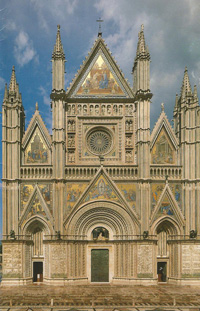 |
|
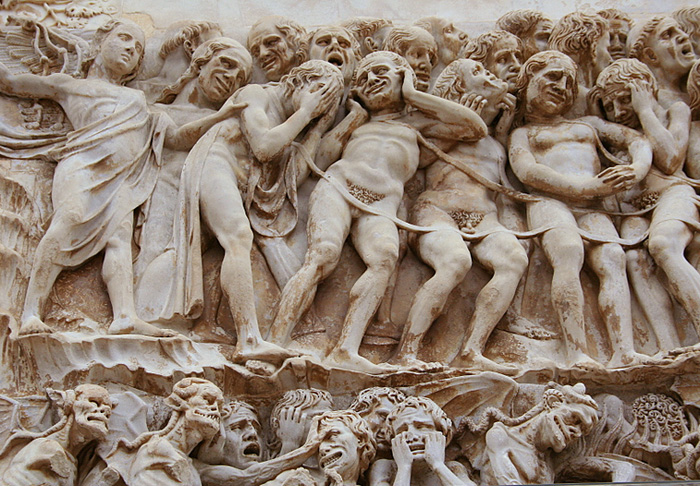 |
||
Facade of Duomo di Orvieto - Reliefs of the forth pillar, depicting the Last Judgment (the damned, detail) |
||
| Interior |
||
| Like the exterior the interior is also characterized by alternating courses of white travertine and green-black basalt and is subdivided into a nave and two aisles with imposing piers with richly sculptured capitals. Immediately upon entering is the monumental BAPTISMAL FONT(1) by Sienese workers, dating to between 1390 and 1407. Originally a bronze statue of St. John the Baptist by Donatello (1424), now lost, stood on top. In the left aisle, in correspondence to the space reserved for the Baptistery, is the splendid fresco of the Madonna Enthroned with the Child and Angels, painted by Gentile da Fabriano in 1425 (2). Continuing along the five side chapels are fragments of fourteenth-fif teenth century frescoes: in particular of the Stories of St. Catherine ofA/exandria by Ugolino di Prete Ilario da Orvieto (3); St. Helen (4); St. Anselm Bishop, the Crucifixion, St. Sebastian and St. George (5); St. Anthony Abbot, St. Catherine of Alexandria and St. Leonard (6). Further on a fourteenth-century gate leads to the transept (7). A second gate (8) signed by Matteo dl Ugolino da Bologna (1355-1362) opens onto the Chapel of the Corporal. Chapel of the Corporal (9). Added between 1350 and 1356 to the north arm of the transept, the chapel takes its name from the relic of the Eucharistic miracle of Bolsena, housed in the marble tabernacle (10) attributed to Andrea di Cione known as Orcagna. The altar cloth or corporal stained with drops of blood that issued from the hostdunng the Mass of Bolsena (1263) is exhibited for worship in the central bay. In 1729 two marble Angels (11-12) by the Roman sculptor Angeto Comacchini were set on either side of the tabernacle. Exactly a hundred years after the emanation of the papal bull that instituted the solemn feast of Corpus Christi extending it to the entire Church (1264), the Orvieto painter Ugolino di Prete llario finished and signed the decoration of the chapel (1364). The scenes narrate the story of the miracle as well as other Eucharistic miracles in medieval tradition as well as episodes from the life of Moses, Elias and Abraham. The salvific sacrifice of Christ on the Cross is depicted on the altar wall. The story of the miracle and of the Passion of Christ are illustrated in the enamel panels of the precious silver RELIQUARY (13), commissioned by the bishop of Orvieto Beltramo Monaldeschi from the Sienese goldsmith Ugolino di Vieri. In its shape the reliquary reflects the three-gabled facade of the cathedral and was finished and signed by the artist in 1338. On the left wall is a small one-light stained glass window with the Crucifixion (14) signed by Duilio Cambellotti in 1924. The Gothic niche on the right contains the panel of the Madonna dei Raccomandati (or of Mercy) (15) by Lippo Memmi, Sienese painter, of 1320. Niches on either side of the gate on the wall outside the Chapel contain statues of the Virgin Mary (16) and the Resurrected Christ (17) by Raffaello da Montelupo (1563). Above the entrance is the monumental ORGAN (18) designed and sculptured in the sixteenth-century by Ippolita Scalza, the principal sculptor, architect and capomastro of the cathedral workyard in the second half of that century. The marble altar of the Visitation (19) in the transept, left upon leaving the chapel, brought the new narrative style of the Holy House of Loreto to the Orvieto work yard together with its sculptors, Simone Mosca, his son Francesco, and Raffaello da Montelupo (1547). On the right of the chapel entrance is the sculpture of the Pieta (20), by Ippolito Scalza (1579) and opposite is Christ at the Column (21) by Gabriele Mercanti (1627). A marble staircase leads to the TRIBUNE or chancel (22), splendidly decorated with frescoes by Ugolino di Prete lIario with Stories of the life of Mary (1370-1380), in four tiers on the walls. The back wall has a large ogival four-light STAINED-GLASS WINDOW (23) with a small rose window at the top. The decorative theme is the same as that of the frescoes and the stained-glass panels were created by the painter and master glass worker Giovanni di Bonino da Assisi between 1325 and 1334. The majestic wooden CHOIR STALLS (24), with sculptures and intarsia by Sienese craftsmen under the direction of Giovanni Ammannati (1329-1340), are set against the walls. Originally located in the nave at the crossing, in the area marked by the marble floor inlaid with Farnese lilies, they were moved in the first half of the sixteenth century and subsequently restored between 1859 and 1890 (those parts that were replaced are now in the Museum of the Opera del Duomo). At the center, on the high altar, is the splendid fourteenth-century Crucifix (25) attributed to Lorenzo Maitani. The external pilaster of the entrance arch of the chancel has a devotional painting of the Imago pietatis with the Mass of St. Gregory (26) attributed to Piermatteo d'Amelia (1479-1482). The statue of the Eece Homo (27) by lppolito Scalza (1608) is right in front of the fresco and opposite is the octagonal wooden pulpit (28) with sculpture by Gabriele Mercanti (1622). Next is the marble altar of the Magi (29), by Michele Samicheli and Simone Mosca (1514-1546). The entrance to the Cappella Nova or of San Brizio follows. On either side of the entrance arch, closed by the sixteenth-century wrought-iron gate in imitation of its medieval predecessor, are the statues of Adam (30) and Eve (31) by Fabiano Toti. La Cappella Nova o di San Brizio |
||
|
||
The Cappella Nova o di San Brizio(32). Added to the left flank of the transept between 1406 and 1444, decoration was begun in 1447 by the Dominican friar Giovanni da Fiesole, known as Fra Angelico, who painted the vault segment above the altar with Christ in Judgment surrounded by crowds of Cherubim, Seraphim, Thrones and Angels, and the left segment with Prophets. Work was interrupted for half a century, till 1499 when Luca Signorelli of Cortona, -tamosls simus pictor in tota ttalla- was commissioned to complete the decoration. In only a few years the painter from Cortona painted the vaults, left unfinished by Fra Angelico, with the Apostles, the Symbols of the Passion (inner segment), the Doctors of the Church, the Martyrs, the Patriarchs, the Virgins (segment over the entrance). The scenes on the entrance wall depict the End of the World. Narration of the Last Things continues with the Preaching of the Antichrist (1st large lunette on the left), the Resurrection of the Flesh (1st large lunette on the right), the Ascent of the Elect and the Antinferno (on either side of the altar), the Damned (2nd large lunette on the right), and Paradise (2nd large lunette on the left). Grottesques and busts of illustrious men looking out from frames surrounded by episodes taken from their works (Virgil, Dante, Qvid, Statius, Lucretius) are on the lower part of the wall with mythological scenes of tritons and Nereid's running along the base. In the small chapel to the right (33) is a Pieta with Saints Pietro Parenzo and Faustino. |
||
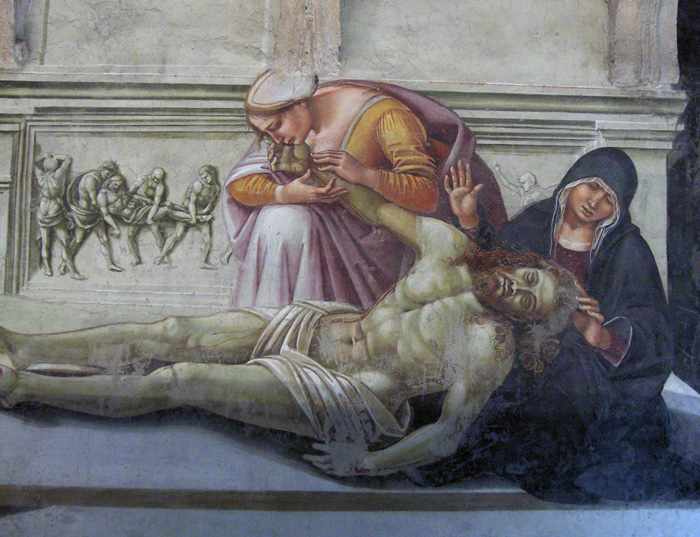 |
||||
Pietà by Luca Signorelli and his school (1499-1504), San Brizio Chapel |
||||
|
||||
| Modernization of the Chapel began in 1622, with the solemn transferal to the interior of the ancient and venerated panel of the Madonna of San Brizio (34), for which the chapel is also named. Subsequently an imposing late-Baroque altar designed by Bernardino Cametti (1712-1715) was installed to provide the image with more suitable housing. To the left upon entering is a small chapel originally dedicated to Mary Magdalen, later turned over and renovated by the noble Orvieto family Gualterio (18th cent.). It houses a painting of Saints in Sacra Conversazione (36) by the Roman artist Domenico Maria Muratorai (ca 1724). The fourteenth-century gate (37) signed by Conte di Lello Orlandi of Siena (1337) leads to the right aisle. The five small side chapels include: the chapel of St. Francis (38), second half of the nineteenth century, by Giovanni Bandini da Siena; fragments of fourteenth-fifteenth century frescoes depicting the Madonna and Child and a saint (39); Crucifixion, Saints John the Baptist and James the Greater (40); Saints Anthony Abbot and Roch (41); St. Sebastian and Madonna and Child (42). The fine marble holy water font by Antonio Federighi da Siena, capomastro of the cathedral work yard between 1451 and 1456, is near the counter-facade. To be remembered is the fact that between the 16th and 18th century an imposing and articulated iconographic program was carried out to conform the Orvieto cathedral to the dictates of the Counter Reformation: the ten small chapels of the side aisles were decorated with altars and paintings of Christological subjects; sculptured figures of the Apostles were set up along the piers of the nave, and the statues of the Annunciation by Francesco Mochi were set on either side of the high altar. This phase was dismantled in the second half of the nineteenth century when a radical "restoration" was undertaken. The altar paintings and monumental statues once in the cathedral are now in the Museum dell'Opera. |
||||
|
||||
Podere Santa Pia, garden |
Podere Santa Pia |
Podere Santa Pia, garden
|
||
Castel Viscardo |
Cortona |
Lago Corbara and Orvieto
|
||
|
||||
Spoleto, Duomo |
Abbey of Sant 'Antimo |
|||
[Source: Le meraviglie del Duomo di Orvieto (ingl.)]. |
||||

